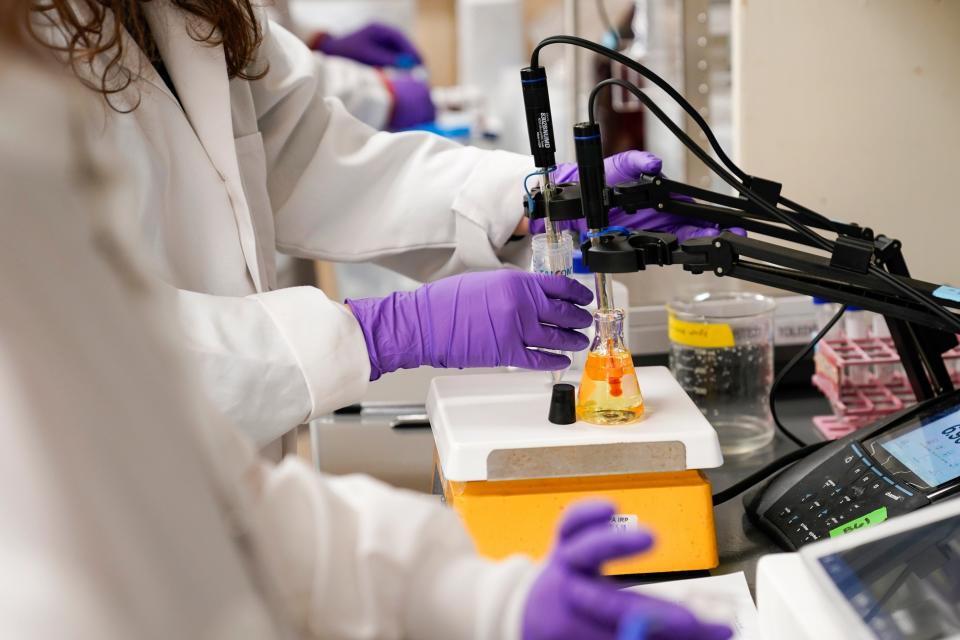Dangerous levels of PFAS detected in water for 27 million. Did the EPA find it near you?
Toxic “forever chemicals” are far more widespread through the country’s drinking water systems than previously known, according to new Environmental Protection Agency data released Thursday.
A USA TODAY analysis shows hundreds of community water systems, serving more than 27 million Americans, found at least one of 29 types of these chemicals in concentrations that exceed the EPA’s new, lower reporting limits.
Per- and polyfluorinated alkyl substances, or PFAS, are a family of chemicals widely used for years in nonstick coatings, water-repellent fabrics and other household and industrial products, but they’re now known to increase the risk for some cancers, among other harmful health effects. Some call PFAS 'forever chemicals' because they're nearly indestructible and can build up over time in human bodies.
“You can’t institute any changes in your home if you don’t have information,” said Jamie DeWitt, professor of pharmacology and toxicology at East Carolina University. “This, at a minimum, is providing information to communities about what they may need to do at the community or household level to reduce their exposures if their exposures are above the proposed limits.”
Map: Where the EPA found pollutants
This map shows water systems included in the EPA's records, as of Aug. 17. It’s based on boundaries developed by SimpleLab, a water-testing company. Click on a system to see the number of pollutants detected at or above the EPA's minimum reporting levels and how much the most concentrated pollutant exceeded those levels. If you don't see a map, click here.
Yoonserk Pyun|USA TODAY
The new data represent a fraction of the additional PFAS sample results from thousands of public water systems that the EPA expects to collect and publish over the next few years.
Of the nearly 2,200 systems included so far, 431 measured PFAS above the EPA’s reporting levels, according to a USA TODAY analysis of the data. That’s almost 20%.
A decade ago, the EPA required drinking water systems to test for just a handful of PFAS compounds at much higher acceptable levels. Only 177 systems reported exceeding limits then – or about 4% of nearly 5,000 systems sampled.
Already, USA TODAY’s analysis shows, the chemicals have turned up in all but a handful of states. Approximately 30% of Alaskans rely on a water system that exceeds a PFAS limit. In Delaware, Arizona, and Texas, it’s about a quarter of each state’s population.
Suffolk County, New York, ties with the city of Fresno, California, and Robeson County, North Carolina, for the highest number of unique PFAS contaminants found above the EPA’s limits: 10.
“Suffolk County has expanded its own laboratory capability for testing PFAS in drinking water and has supported the efforts of the New York State Department of Health to establish stringent drinking water standards for PFOS,” said Gregson H. Pigott, the Suffolk County Department of Health Services commissioner, in a written statement.
PFOS, or perfluorooctane sulfonic acid, is among the most common PFAS chemicals.
There are no national standards for PFAS
There are no enforceable national drinking water standards in the U.S. for PFAS. Some states, including New Jersey and Wisconsin, have adopted their own enforceable maximum contaminant levels for several types of PFAS.
Earlier this year, the EPA proposed legally enforceable limits on six PFAS chemicals in drinking water, including PFOS, but until that’s finalized, public water systems are not required to take any action. The agency has issued health advisories for four chemicals included in the latest data release. However, these are only guidelines.

“Utilities do not have to follow health advisories because they’re not legally enforceable,” said DeWitt, the East Carolina professor. “But at least with respect to facilities managers with whom I have spoken, they all are working to ensure that the water they provide to their customers does meet health advisory levels, even though they don't have to do it."
In July, the U.S. Geological Survey released a study estimating that at least 45% of the nation’s tap water has one or more types of PFAS. Scientists collected residential tap water samples from 716 locations that comprised private wells and public supply taps.
It may be hard to protect yourself from PFAS
There is limited information on PFAS in residential tap water at the point of use, especially from private wells, whose maintenance and monitoring fall to the owner. Private wells are not regulated in the U.S., yet about 40 million people nationwide rely on them for drinking water, according to the USGS study.
Most national testing programs have omitted private wells and rarely captured information from rural communities, even though 52 million people rely on small water systems serving populations under 10,000, according to the USGS study.
To address this, the EPA’s latest data release focuses on both small and large utilities.
“There should be more information in the next couple of years for some of the folks in rural America,” said Kelly Smalling, a research hydrologist at the USGS and the study’s lead author.
In the meantime, the EPA suggests people who get their water from affected systems should consider adding in-home filtration systems for peace of mind. They say some techniques, such as nanofiltration and reverse osmosis, can be extremely effective at removing PFAS.
Many communities will soon receive EPA grants to help mitigate PFAS contamination through the Bipartisan Infrastructure Law, which is directing $9 billion to affected systems over the next several years.
“What we’re suggesting folks do is first understand their own personal risk,” Smalling said. “Risk is personal. Some people will be really alarmed and others aren’t. If you’ve decided this is something you’re concerned about, get informed. Talk to your state public health officials. Can you treat your water? Can you get it tested? Talk to your legislators. They’re the ones that make the regulations and policy.”
This article originally appeared on USA TODAY: PFAS pollutes drinking water for 27 million Americans, EPA says

